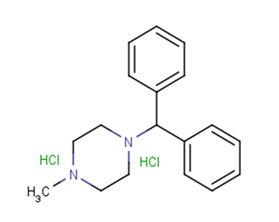
Cyclizine dihydrochloride
CAS No. 5897-18-7
Cyclizine dihydrochloride( —— )
Catalog No. M18859 CAS No. 5897-18-7
Cyclizine Dihydrochloride is a histamine H1 antagonist. It is given by mouth or parenterally for the control of postoperative and drug-induced vomiting and in motion sickness.
Purity : >98% (HPLC)
 COA
COA
 Datasheet
Datasheet
 HNMR
HNMR
 HPLC
HPLC
 MSDS
MSDS
 Handing Instructions
Handing Instructions
| Size | Price / USD | Stock | Quantity |
| 25MG | 45 | In Stock |


|
| 50MG | 59 | In Stock |


|
| 100MG | 106 | In Stock |


|
| 200MG | 193 | In Stock |


|
| 500MG | Get Quote | In Stock |


|
| 1G | Get Quote | In Stock |


|
Biological Information
-
Product NameCyclizine dihydrochloride
-
NoteResearch use only, not for human use.
-
Brief DescriptionCyclizine Dihydrochloride is a histamine H1 antagonist. It is given by mouth or parenterally for the control of postoperative and drug-induced vomiting and in motion sickness.
-
DescriptionCyclizine Dihydrochloride is a histamine H1 antagonist. It is given by mouth or parenterally for the control of postoperative and drug-induced vomiting and in motion sickness.
-
In VitroCyclizine (100 μM) dihydrochloride significantly inhibits nitrite accumulation and iNOS protein levels in the LPS-stimulated in RAW 264.7 cells supernatants.Cyclizine dihydrochloride inhibits anti-IgE-induced histamine release from isolated human lung fragments, with an IC50 of 5.42 μM.
-
In VivoCyclizine (1, 10 mg/kg) dihydrochloride enhances locomotor activity of mice in a dose-dependent manner. Animal Model:Naive male CDI mice (Charles River) weighing 25-30 g Dosage:1, 10 mg/kg Administration:s.c.; locomotor activity (crossings) measured every 15 min for 2 hr.Result:Enhanced locomotor activity in a dose-dependent manner.
-
Synonyms——
-
PathwayOthers
-
TargetOther Targets
-
RecptorH1 receptor
-
Research Area——
-
Indication——
Chemical Information
-
CAS Number5897-18-7
-
Formula Weight339.3
-
Molecular FormulaC18H24Cl2N2
-
Purity>98% (HPLC)
-
Solubility——
-
SMILESCN1CCN(CC1)C(c1ccccc1)c1ccccc1.Cl.Cl
-
Chemical Name——
Shipping & Storage Information
-
Storage(-20℃)
-
ShippingWith Ice Pack
-
Stability≥ 2 years
Reference
1. Vella-Brincat JW, et al. J Pain Symptom Manage. 2012 Mar;43(3):540-8.
molnova catalog



related products
-
LY3372689
LY3372689 (Formulaic Ia) is an orally active O-GlcNAcase (OGA) enzyme inhibitor targeting tau protein-based disorders, including Alzheimer's disease.
-
5,8-Epidioxyergosta-...
9,11-Dehydroergosterol peroxide is a useful organic compound for research related to life sciences.
-
EAAT2 activator 1
F2005-0304 is a thiopyridazine derivative that has been found to increase EAAT2 protein levels in astrocytes.



 Cart
Cart
 sales@molnova.com
sales@molnova.com


